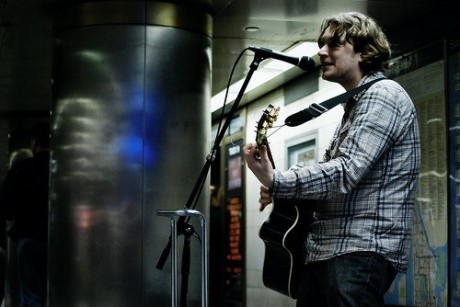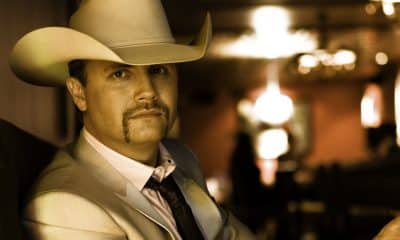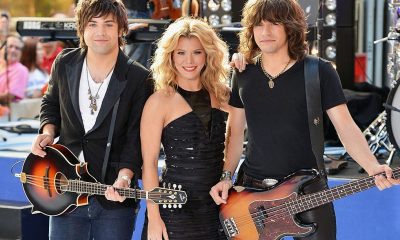Columns
The Noise Beneath The Apple
The Latin root ‘busk’ can be traced back to ‘buskin, which was a decorated sandal worn by Roman street performers. Historic records from that time also indicate the practice of throwing coins to street performers; the first tips. From here, the travels and evolution of the word busker are as varied and puzzling as the profession itself.
 In obsolete French, ‘busque’r, was used to describe another of the world’s oldest professions, a service exchanged for alms; prostitution. In Italian, buskers were known as ‘buscarsi’, stemming from the root “to procure or gain.” In Spain, the root means “to seek”—as in seeking fame and fortune. The most famous early buskers are the gypsies, from Romania. The Romani people are well known as fortune tellers, dancers, musicians and wandering entertainers, and it is they who are credited with bringing busking—the profession and the term—to England.
In obsolete French, ‘busque’r, was used to describe another of the world’s oldest professions, a service exchanged for alms; prostitution. In Italian, buskers were known as ‘buscarsi’, stemming from the root “to procure or gain.” In Spain, the root means “to seek”—as in seeking fame and fortune. The most famous early buskers are the gypsies, from Romania. The Romani people are well known as fortune tellers, dancers, musicians and wandering entertainers, and it is they who are credited with bringing busking—the profession and the term—to England.
My favorite association of the word appears in 1851, in the writings of Augustus Septimus Mayhew (an English journalist and author), who used it in The Greatest Plague of Life while describing a lifestyle of shiftless, vagabond buskers—a lifestyle reserved for those lowly looters and libertines, the pirates.
Busking history is rich; filled with controversy, character and intrigue. From medicine shows in the early eighteen hundreds—complete with snake charming, juggling and fire breathing—to one-man bands in the early nineteen hundreds, busking has been alive and well in the United States.
Buskers themselves, fall into a myriad of categories. There are those who create “circle shows,” usually drawing people into large crowds around them. These shows have a definite beginning and end; a skit, dance routine, comedy or ventriloquism. Then there’s café busking, where performances are done in exchange for tips—those tips often collected via a “passing of the hat” (Joni Mitchell, Joan Baez and Bob Dylan, started in this way and the 1973 hit, Piano Man, by Billy Joel, was inspired by his six months as a café busker in Los Angeles).
Still another type of busker is one who embodies a magic that is exclusively their own, yet extraordinarily communal. We walk by them, playing their guitars, singing their songs, performing their music. We may smile at them. We may not. We may hurriedly drop a buck in their open guitar case. We may not. We may stop and watch. We may not.
In the world of this busker, none of these things matter. They are there because they belong there. The streets have called them; the world underfoot has beckoned them. Like The Velveteen Rabbit, they become more real than the trains whizzing by, more concrete than the skyscrapers overhead. And they give the city a life and a breath, an undercurrent of alchemy that would not exist if they were not there. They invite us to sing out of key, to dance out of step, not necessarily trying to discern the meaning of life, but rather, to experience being truly alive.
These are their songs. These are their stories. These are the common threads that connect us all. And as we journey into the heart of this breed of busker, we discover, as Maya Angelou says, “that we are more alike than unalike”.
It was Christmas 2009. I found myself drinking rum, listening to rock & roll and reflecting. Reflecting is what we do at that time of year; the rum and rock & roll simply make that reflection easier to swallow.
I was living in Los Angeles. I had no boyfriend. I had no lover. I didn’t own a home or a dog; I didn’t even have an air fern. What the hell was I doing in Los Angeles?
Two weeks later, I was smack dab in the middle of New York City. I found myself in the midst of the mad, mad ones; those daring souls who had taken their art to the streets and made the city their stage. They were without limits; boundless; free from the shackles of conformity. I was mystified and enchanted, exactly like Mr. Kerouac had predicted.
I bought an unlimited Metro Pass and began exploring the city’s nuances, her character, in the heart of winter. At the 59th/Columbus Circle stop in the Upper West Side, I came across Luke Ryan; a busker with soul, entertaining an invisible crowd, in the three-degree subway.
He sang Springsteen tunes and swayed to the sound of his own voice. He bantered with the non-existent onlookers:
“Oh, there’s the Venti Starbucks cup. It’s all downhill from here. I’m gonna call it a day. Thanks so much for stopping by.”
I looked around and wondered if he was aware that no one was there.
And then I saw his sign, handwritten, leaning against his worn guitar case. “I’m not here and neither are you,” it said.
A nattily dressed man in an Armani suit scurried by, intently focused on the train track ahead.
Luke, whose beard is going gray in two perfectly vertical lines straight down his chin, is an elf-like character with a mischievous twinkle in his eye. Like a sparkplug, he is stout, square and full of charge. He looked at the man in the Armani and shouted out, “Mad Dog!”
Armani Man halted.
“You look great. You’re all cleaned up. You’re out of the joint. Good for you.”
Armani Man ducked into the first open train door, without noticing that it was a Queens bound N. “We used to be cell mates,” Luke said to me. “I was the husband.”
That was worth a buck and I gladly dropped a dollar into Luke’s case.
Luke has played the subways for over 30 years, for such spectators as Abbie Hoffman and Tom Waits. He played there back when the city danced to war and protest songs. He played there when that same city reeled from the shock of 9/11, then grieved and healed. He’s been chased, ticketed and embraced by the NYPD as busking evolved from a romantic notion to a legitimate occupation to an illegal activity (which is where it stands today). From freezing to sweltering temperatures, harassment from the homeless to the NYPD, legal battles, arrests, confinement, First Amendment Rights controversies, incarceration, tickets and fines, Luke continues to play.
In future editions of this column, we’ll meet “The Saw Lady,” one Natalia Paruz, who has played Madison Square Garden and Carnegie Hall. She still calls the New York Subway her musical home. The idealistic Theo Eastwind—baker turned busker—with his blond hair and sharp blue eyes, able to recite the First Amendment and all of its nuances in four languages. We’ll meet the indomitable Alice Ridley Tan, an 18-year veteran of the New York underground and mother to Gabourey Sidibe, the Oscar-nominated star of the film Precious.
We’ll meet these people and many more, hear their stories, listen to their songs and explore the controversy that swirls around them in the New York underground. And no matter what form of transportation you use—a John Deere tractor, an Italian Vespa, a magic carpet or the city trains—may you be transported to a different place than you were when you started.

- Lists13 years ago
Top 10 Country Music Albums of 2010

 Interviews5 years ago
Interviews5 years agoJohn Rich – The Interview

 Song Reviews16 years ago
Song Reviews16 years agoTaylor Swift – “Love Story”

 Interviews5 years ago
Interviews5 years agoHoneyhoney on Hiatus: Revisit our 2008 Interview with Suzanne Santo

 Album Reviews14 years ago
Album Reviews14 years agoAlbum Review: Miley Cyrus – Can’t Be Tamed

 Song Reviews6 years ago
Song Reviews6 years agoThe Band Perry – “Hip To My Heart”

 Columns5 years ago
Columns5 years agoThe Link Between Folk Music’s Past and Present

 Columns5 years ago
Columns5 years agoIs Marketing Killing Rock and Roll?
